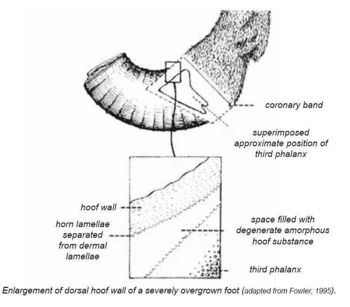Foot Conditions - Donkey
| This article has been peer reviewed but is awaiting expert review. If you would like to help with this, please see more information about expert reviewing. |
Unless otherwise stated, the following conditions are described with respect to donkeys kept in the U.K. and similar environments.
Trimming of the overgrown foot

- The principles are basically the same as for routine trimming.
- The structural relationship between the coronary band and the distal phalanx is maintained. The whole overgrowth is composed of insensitive and often degenerate wall, sole and frog tissue.
- Donkeys often suffer from chronic foot disease with varying degrees of change.
- Good quality weight-bearing lateral radiographs are a very useful guide for trimming and prognosis.
- Excise degenerate material - e.g. seedy toe
- The white line is often enlarged as a result of disruption of normal laminar structure.
- Dress the hoof wall to restore the normal relationship between the hoof capsule and the distal phalanx.
- Consequently, the sole may need to bear more wight and enough thickness needs to be maintained to prevent excessive discomfort to the donkey. Provision of a deep bedded stable is also useful.
- Most donkeys respond well to improved angle of the foot without the need for prolonged analgesia. Daily inspection and good hoof hygiene are advisable as well as monthly farriery as indicated until a substantial hoof capsule has developed.
The lame donkey
It is often in an advanced stage that a lameness is recognised in a donkey kept as 'pasture ornament'. They are often recumbent for prolonged periods and may have depressed appetite, which increases the risk of hyperlipaemia. Full clinical examination should be performed and if in doubt, at least a visual inspection of serum/plasma from a blood sample. Hospitalised donkeys are at risk of intestinal obstruction and should be closely monitored, especially those fed a more dry, fibrous diet. Analgesics may mask the signs of colic. Few donkeys will trot up in-hand like horses for a lameness investigation, therefore free exercise in an enclosed space may be more rewarding. Standard regional analgesia may be emplyed, however, small size of some joints may limit the intra-articular anaesthesia.
References
- Crane, M. (2008) The donkey's foot In Svendsen, E.D., Duncan, J. and Hadrill, D. (2008) The Professional Handbook of the Donkey, 4th edition, Whittet Books, Chapter 10
- Budras, K.D., Schiel, C., and Milling, C. (1998). ‘Horn Tubules of the White Line; an insufficient barrier to ascending bacterial invasion’. Equine Veterinary Education 10 (2). pp 81-85.
- Crane, M. (2003). ‘Foot Problems in the Donkey’. Veterinary and Farriery Practice: the Common Ground. Proceedings of the 5th Biannual Seminar BEVA and NAFB & AE Conference, Stoneleigh. 21 October 2003. pp 12-14.
- Eley, J.L., French, J.M. (1993). ‘Chronic Founder in the Donkey’. Proceedings of the 5th Biannual Seminar BEVA and NAFB & AE Conference, Stoneleigh. 21 October 2003. pp 12-14.
- Eustace, R. A. (1992). ‘Explaining Laminitis and its Prevention’. E.F.S. Equine Series 1. Title II. series 636.1. (ISBN 0-9518974-0-3)
- Fowler, J. (1995). ‘Trimming donkeys’ feet’. Equine Veterinary Education 7. pp 18-21.
- Keller, M., Stanek, C., Krehon, S., and Rosengarten, R.. (2000). ‘Keratopathogenic mould fungi and dermatophytes in healthy and diseased hooves of horses’. Veterinary Record 147. pp 619-622.
- Newlyn, H.A., Collins, S. N., Cope, B. C., Hopegood, L., Latham, R. J., and Reilly, J.D. (2004). ‘Equid Hoof Horn: a Natural Composite?’ Proceedings of the 5th International Conference on Deformation and Fracture of Composites. I.O.M. Communications Ltd, London, U.K. March 1999. pp 231-240.
- Pollitt, C.C. (1998). ‘The anatomy and physiology of the hoof wall’. Equine Veterinary Education 10 (6). pp 318 –325.
|
|